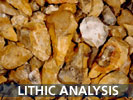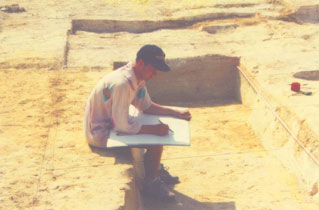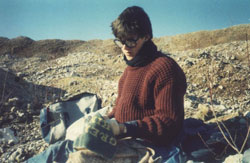|
Boxgrove Fieldwork has been directed at Boxgrove since 1982 by Mark Roberts of University College London, and funded by English Heritage. The site contains an extensive land-surface containing undisturbed artefacts and faunal remains accumulated over a period of maybe 20 to 100 years, as well as other undisturbed horizons in certain places, and abundant small mammalian and micro-palaeontological evidence. The oldest hominid remains in Britain (comprising part of a left tibia) were found at the site in December 1993, followed by two teeth from a different horizon in September 1995. I first became involved with the site in September 1983 as a volunteer, and continued as a site supervisor in the 1980s and eventually became the senior supervisor for excavation of the hominid site in 1995 and 1996.
Working at Boxgrove provided the perfect environment to develop an interest in flint-knapping and experimental archaeology, leading to a number of experiments in handaxe manufacture that confirmed the extensive use of soft-hammer working at Boxgrove a decade before the antler and bone soft-hammer finds of the 1995–1996 fieldwork.
References Roberts, M.B., Parfitt, S.A., Pope, M.I & Wenban-Smith, F.F. 1997. Boxgrove, West Sussex: rescue excavations of a Lower Palaeolithic landsurface (Boxgrove Project B, 1989-91). Proceedings of the Prehistoric Society 63: 303–58. Wenban-Smith, F.F. 1999. Knapping technology. In M.B. Roberts & S.A. Parfitt (ed's) Boxgrove: a Middle Pleistocene Hominid Site: 384–395. English Heritage, London. |
|
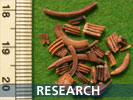 |
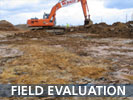 |
 |
 |

